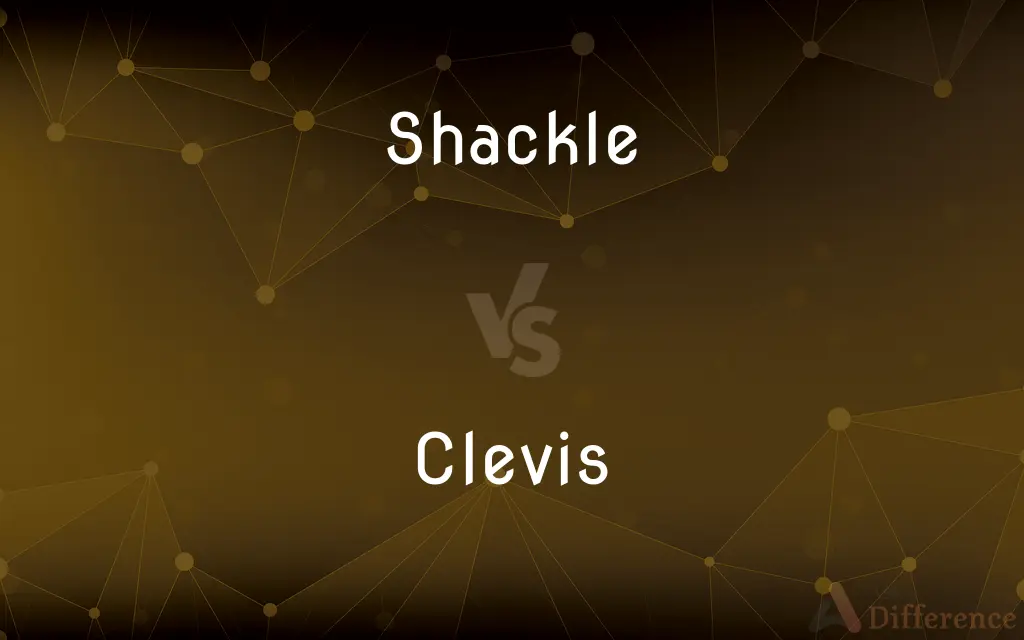Shackle vs. Clevis — What's the Difference?
By Tayyaba Rehman — Updated on November 2, 2023
A shackle is a U-shaped piece of metal secured with a pin or bolt, while a clevis is a U-shaped or forked metal piece with holes for a pin securing a rod or bolt.

Difference Between Shackle and Clevis
Table of Contents
ADVERTISEMENT
Key Differences
A shackle is typically used to connect the lifting component of a crane to the load, designed to support movement and heavy loads. Clevis, on the other hand, is often used to connect moving parts in a mechanism, such as a rod end or a hydraulic cylinder. Shackles usually have a threaded pin or bolt that can bear significant loads and are used in applications like sailing, industrial lifting, and rigging. Clevises are part of a clevis pin system and are used in applications that require a pivot point with motion, such as in agricultural equipment or in the automotive industry.
Shackles can be used as part of a clevis pin assembly but are distinct in their load-bearing capabilities and are often heavier duty. Clevises are designed to allow for lateral and rotational movement, often used with clevis pins to fasten two parts together. The shackle is a critical component in safety-critical applications, requiring robust design and testing standards. Clevises, while also designed for strength, are not typically the sole load-bearing component in a system and may not be as robust as shackles.
Shackles are selected based on load capacity, size, type of pin, and suitability for the environment, whereas clevises are chosen for the type of motion required and the alignment of the parts they are connecting. Shackles need to be inspected regularly for wear and deformation, especially the pin, since failure can be catastrophic. Clevises require less stringent inspection, with focus often on the wear of the holes and the condition of the clevis pin.
The design of a shackle is governed by standards that specify the minimum requirements for their performance and safety, such as the lifting capacity and environmental resistance. Clevis designs are dictated by the specifications of the machinery they will be a part of, focusing on the proper fit and articulation rather than on lifting capacity.
Comparison Chart
Primary Use
Lifting and rigging applications.
Connecting moving parts in a mechanism.
ADVERTISEMENT
Shape
U-shaped, closed with a pin or bolt.
U-shaped or forked, paired with a clevis pin.
Load Capacity
High load-bearing capabilities.
Less load-bearing, more for motion.
Movement
Limited to pivoting on one axis.
Allows for rotational and lateral movement.
Industry Standards
High safety and performance standards.
Varies with the machinery design requirements.
Compare with Definitions
Shackle
A restraint or limitation.
He felt shackled by his desk job.
Clevis
A U-shaped fastening device.
We attached the plow to the tractor with a clevis.
Shackle
A metal link for securing a load.
We used a shackle to lift the container.
Clevis
A coupling for rods or cables.
A clevis was used to join the control rods.
Shackle
A looped bolt in rigging setups.
The shackle connected the rope to the sail.
Clevis
A forked piece of metal in mechanics.
The clevis allowed the rod to pivot smoothly.
Shackle
A securing device in heavy machinery.
The shackle was crucial to the crane's operation.
Clevis
An attachment point in agricultural machinery.
The clevis ensured the attachment of the harrow.
Shackle
A shackle, also known as a gyve, is a U-shaped piece of metal secured with a clevis pin or bolt across the opening, or a hinged metal loop secured with a quick-release locking pin mechanism. The term also applies to handcuffs and other similarly conceived restraint devices that function in a similar manner.
Clevis
A part of a clevis pin joint.
The clevis and pin secured the linkage.
Shackle
A device, usually one of a pair connected to a chain, that encircles the ankle or wrist of a prisoner or captive.
Clevis
A U-shaped metal piece with holes in each end through which a pin or bolt is run, used as a fastening device.
Shackle
A hobble for an animal.
Clevis
A U-shaped coupling having holes at each end, through which a bolt is run; used especially to fit attachments to a tractor or other vehicle as it allows a degree of rotation about the bolt.
Shackle
Any of several devices, such as a clevis, used to fasten or couple.
Clevis
A piece of metal bent in the form of an oxbow, with the two ends perforated to receive a pin, used on the end of the tongue of a plow, wagen, etc., to attach it to a draft chain, whiffletree, etc.; - called also clavel, clevy.
Shackle
Often shackles A restraint or check on action or progress
"throwing off the puritanical shackles" (Ben Yagoda).
Clevis
A coupler shaped like the letter U with holes through each end so a bolt or pin can pass through the holes to complete the coupling; used to attach a drawbar to a plow or wagon or trailer etc.
Shackle
To put shackles on (someone); confine with shackles.
Shackle
To fasten or connect with a shackle.
Shackle
To restrict, confine, or hamper.
Shackle
A restraint fit over a human or animal appendage, such as a wrist, ankle or finger; normally used in pairs joined by a chain.
Shackle
A U-shaped piece of metal secured with a pin or bolt across the opening, or a hinged metal loop secured with a quick-release locking pin mechanism.
Shackle
A restraint on one's action, activity, or progress.
Shackle
A fetter-like band worn as an ornament.
Shackle
A link for connecting railroad cars; a drawlink or draglink.
Shackle
A length of cable or chain equal to 2 fathoms or 75 feet, or later to 15 fathoms.
Shackle
(transitive) To restrain using shackles; to place in shackles.
Shackle
To render immobile or incapable; to inhibit the progress or abilities of.
This law would effectively shackle its opposition.
Shackle
(dialectal) To shake, rattle.
Shackle
Stubble.
Shackle
Something which confines the legs or arms so as to prevent their free motion; specifically, a ring or band inclosing the ankle or wrist, and fastened to a similar shackle on the other leg or arm, or to something else, by a chain or a strap; a gyve; a fetter.
His shackles empty left; himself escaped clean.
Shackle
Hence, that which checks or prevents free action.
His very will seems to be in bonds and shackles.
Shackle
A fetterlike band worn as an ornament.
Most of the men and women . . . had all earrings made of gold, and gold shackles about their legs and arms.
Shackle
A link or loop, as in a chain, fitted with a movable bolt, so that the parts can be separated, or the loop removed; a clevis.
Shackle
A link for connecting railroad cars; - called also drawlink, draglink, etc.
Shackle
The hinged and curved bar of a padlock, by which it is hung to the staple.
Shackle
To tie or confine the limbs of, so as to prevent free motion; to bind with shackles; to fetter; to chain.
To lead him shackled, and exposed to scornOf gathering crowds, the Britons' boasted chief.
Shackle
Figuratively: To bind or confine so as to prevent or embarrass action; to impede; to cumber.
Shackled by her devotion to the king, she seldom could pursue that object.
Shackle
To join by a link or chain, as railroad cars.
Shackle
A restraint that confines or restricts freedom (especially something used to tie down or restrain a prisoner)
Shackle
A U-shaped bar; the open end can be passed through chain links and closed with a bar
Shackle
Bind the arms of
Shackle
Restrain with fetters
Shackle
A U-shaped lock device for chaining.
The prisoner was bound in shackles.
Common Curiosities
What does a clevis connect?
A clevis connects two parts of a mechanism allowing for movement and alignment.
Can a clevis be used for lifting?
It's not designed for heavy lifting; its use is more for connecting moving parts.
How is a shackle strength rated?
By its working load limit (WLL) and breaking strength, based on material and size.
Can shackles be used in marine applications?
Yes, stainless steel or galvanized shackles are used to resist corrosion in marine environments.
Are shackles and clevises interchangeable?
No, they serve different purposes and are not typically interchangeable.
Is a clevis pin the same as a bolt?
No, a clevis pin is specifically designed to work with a clevis and usually has a retaining clip.
Where would I commonly find a clevis used?
In automotive systems, agricultural machinery, and aircraft control mechanisms.
Do shackles come in different shapes?
Yes, including D-shape, bow, and long reach shackles for different applications.
Can a clevis be repaired?
It depends on the wear; sometimes it's replaceable or repairable by a qualified professional.
What safety considerations are there for shackles?
Regular inspection for wear, correct sizing for load, and proper pin securement are crucial.
What is a shackle used for?
Shackles are used for lifting, rigging, and anchoring heavy loads.
How does a clevis account for wear?
Clevises have holes that can wear over time, which can be monitored and replaced if needed.
Are there different types of clevises?
Yes, including standard, adjustable, and special-purpose clevises designed for specific tasks.
Are clevis pins adjustable?
They come in fixed sizes but can be used with different sized holes within certain limits.
What are the common materials for shackles?
Steel, stainless steel, and sometimes aluminum for lighter duty applications.
Share Your Discovery

Previous Comparison
Daunting vs. Difficult
Next Comparison
Beside vs. BesidesAuthor Spotlight
Written by
Tayyaba RehmanTayyaba Rehman is a distinguished writer, currently serving as a primary contributor to askdifference.com. As a researcher in semantics and etymology, Tayyaba's passion for the complexity of languages and their distinctions has found a perfect home on the platform. Tayyaba delves into the intricacies of language, distinguishing between commonly confused words and phrases, thereby providing clarity for readers worldwide.















































